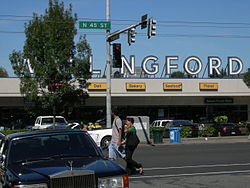Wallingford | |
|---|---|
 | |
 Wallingford highlighted in pink | |
| Coordinates: 47°39′33″N 122°20′10″W / 47.65917°N 122.33611°W | |
| Country | United States |
| State | Washington |
| City | Seattle |
| City Council | District 4 |
| Neighborhood Council | Lake Union District |
| Police District | North Precinct, B3 |
| Legislative District | 43rd |
| Established [1] | Annexed to Seattle on May 3, 1891 |
| Named for | John Noble Wallingford Jr. |
| Area | |
• Total | 1.07 sq mi (2.8 km2) |
| Population | |
• Total | 12,210 |
| • Density | 11,000/sq mi (4,400/km2) |
| ZIP code | 98103 |


Wallingford is a neighborhood in north central Seattle, lying on a hill above the north shore of Lake Union about four miles from the downtown core. The neighborhood developed quickly during the early 20th century after the establishment of the University of Washington to the east. With trolley tracks laid through the neighborhood as early as 1907, Wallingford is a classic streetcar suburb, typified by its many 1920s era box houses and bungalows. Commercial development is primarily concentrated along North 45th Street where a number of iconic structures stand including the neon "WALLINGFORD" sign, the Wallingford Center, and the original Dick's Drive-In. With its central location, numerous public amenities, including the world-renowned Gas Works Park, and views of both the Olympic and Cascade mountains, Wallingford has long been home to many middle and upper-class families. While Wallingford is mostly residential in nature, the neighborhood's southern edge, along Lake Union, has historically been an industrial and commercial business strip. In recent years, numerous office buildings have been developed as an extension of the burgeoning business center in neighboring Fremont. In 2014 Brooks Sports moved its headquarters from Bothell to a new six-story office building at the southwestern edge of Wallingford.
- ^ "Seattle Annexation Map". Archived from the original on 2015-11-15.
- ^ a b c "Based on King County Census Tracts 50, 51, and 54" (PDF). Archived from the original (PDF) on 2012-07-28.